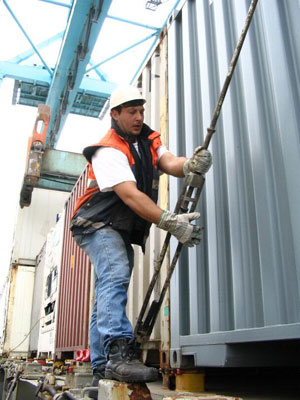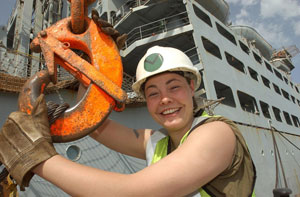Stevedore
Tasks & duties

Stevedores may do some or all of the following:
-
receive instructions by radio telephone (RT) and/or radio data terminal (a computer that receives instructions via radio) to load, unload or move cargo
-
sort cargo before loading and unloading
-
operate heavy vehicles and machinery, such as straddle carriers, fork-lifts and ships' cranes, to load and unload cargo from trucks, ships and rail transport services
-
position goods in the holds of ships
-
secure cargo on the ship by using braces to hold it in place
-
pack containers and repack damaged containers
-
arrange for damaged containers of hazardous material to be quarantined
-
carry out safety checks on equipment
-
wash out containers and carry out other general yard duties such as shunting on the railway
-
secure and release mooring lines of ships
-
clean out ships' tanks and holds
-
complete any necessary paperwork
Specialisations
Stevedores may specialise in operating certain types of heavy vehicles such as straddle carriers, cranes or fork-lifts.
Skills & knowledge

Stevedores need to have:
-
knowledge of the correct health and safety procedures for their port or container terminal
-
skill operating heavy machinery such as straddle carriers, fork-lifts and ship's cranes
-
knowledge of how to handle different types of cargo, particularly containers of dangerous substances
-
knowledge of basic customs and shipping company documents
-
the ability to interpret ship loading plans
-
good communication skills
-
organisational skills
-
first aid skills
Entry requirements
There are no specific entry requirements to become a stevedore, as you gain skills on the job.
However, employers usually prefer you to have a driver's licence because most jobs on wharves involve driving vehicles.
A Class 2 (heavy vehicle) driver's licence with an F endorsement is the minimum needed to drive heavy vehicles such as straddle carriers and large fork-lifts. Licensing is administered by Land Transport New Zealand.
Some employers may require you to pass a medical test.
Secondary education
There are no specific secondary education requirements for becoming a stevedore. However, a good level of general education and literacy are necessary to gain heavy machinery licences. Maths skills are useful for performing basic calculations, interpreting ship loading plans and operating lifting machinery.
Tertiary education
National certificates (Levels 2 to 6) are available in stevedoring, the ports industry and cargo handling.
Tranzqual ITO website - information on stevedoring and ports qualifications
Training on the job
Skills are gained on the job.
First aid and dangerous goods courses are available, along with training for fork-lift and straddle carrier licences. Skills gained on the job can count towards NZQA recognised unit standards.
Related courses
Automotive Vehicle Operations
Marine Craft Operation
Purchasing, Warehousing and Distribution
For more information, please refer to Career Services.
Document Actions
